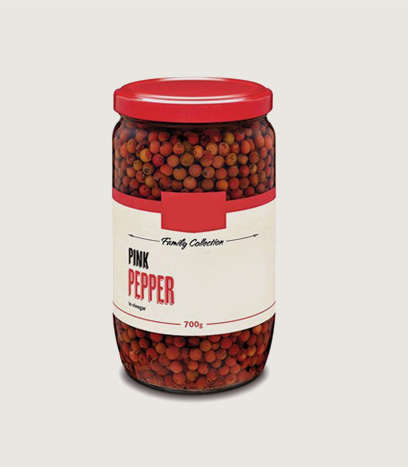Pink Pepper In Brine
The history of the spice trade is, above all, the history of pepper, the ‘King of Spices’. Pepper has been moving westward from India for 4,000 years. It has been used in trading as an exchange medium like money and, at times, has been valued so highly that a single peppercorn dropped on the floor would be hunted like a lost pearl. In classical times ‘tributes’ were paid in pepper, and both Attila the Hun and Alaric I the Visigoth demanded pepper as a substantial part of Rome’s ransom.
Since the Middle Ages, pepper was the core of the European spice trade, with Genoa and Venice dominating the market. The Italian ‘pepperers’ monopoly of overland trade routes was the major determining factor in driving the search for an eastern sea route.
Spice Description
Pepper comes from several species of a vinous plant, the spice being the fruit, called peppercorns. Black pepper is the dried, unripe berry. The corns are wrinkled and spherical, about 5 mm (1/8 in) in diameter. Malabar and Tellicherry pepper are both considered top quality due to size and maturity, with only 10% of the largest corns being graded as Tellicherry. White pepper starts out the same as the black, but are allowed to ripen more fully on the vine. The outer shell is then removed by soaking the berries in water until the shell falls off, or are held under flowing spring water, yielding a whiter, cleaner pepper. Green pepper is from the same fruit but is harvested before they mature. Pink pepper, which is not a vinous pepper, comes from the French island of Reunion. Pink peppercorns have a brittle, papery pink skin enclosing a hard, irregular seed, much smaller than the whole fruit.
Culinary Uses
Pepper is best ground directly on to food. With hot food it is best to add pepper well towards the end of the cooking process, to preserve its aroma. White pepper is used in white sauces rather than black pepper, which would give the sauce a speckled appearance. Green peppercorns can be mashed with garlic, cinnamon or to make a spiced butter or with cream to make a fresh and attractive sauce for fish. Pink peppercorns are called for in a variety of dishes, from poultry to vegetables and fish.
view all products buy this product
